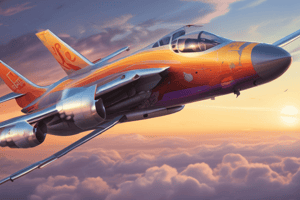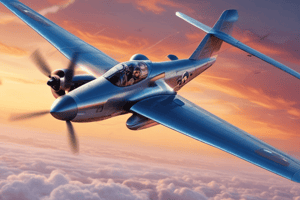Podcast
Questions and Answers
What is the primary function of an airfoil?
What is the primary function of an airfoil?
- To produce weight
- To produce lift (correct)
- To produce thrust
- To produce drag
What is the equation for thrust?
What is the equation for thrust?
Thrust (T) = mass flow rate x velocity change
The shape of an airfoil creates a difference in ___________ between the upper and lower surfaces, resulting in lift.
The shape of an airfoil creates a difference in ___________ between the upper and lower surfaces, resulting in lift.
pressure
What is the primary factor that affects drag?
What is the primary factor that affects drag?
Thrust is the backward force that opposes an aircraft's motion.
Thrust is the backward force that opposes an aircraft's motion.
Lift is the backward force that opposes an aircraft's motion.
Lift is the backward force that opposes an aircraft's motion.
What is the definition of Bernoulli's Principle?
What is the definition of Bernoulli's Principle?
Match the following forces with their definitions:
Match the following forces with their definitions:
The equation for lift is given by L = 0.5 x ___________ x velocity^2 x wing area x lift coefficient.
The equation for lift is given by L = 0.5 x ___________ x velocity^2 x wing area x lift coefficient.
Rotary wings are used in wind turbines to generate lift.
Rotary wings are used in wind turbines to generate lift.
Flashcards are hidden until you start studying
Study Notes
Airfoil
- Definition: A curved surface used to produce lift when air flows over it
- Characteristics:
- Cambered upper surface (curved)
- Flat lower surface
- Angled to oncoming airflow (angle of attack)
- Function: Converts airflow into an upward force (lift) and a forward force (thrust)
Thrust
- Definition: The forward force that propels an aircraft through the air
- Generation:
- Produced by the aircraft's engines (jet or propeller)
- Created by the acceleration of air rearward
- Equation: Thrust (T) = mass flow rate x velocity change
Drag
- Definition: The backward force that opposes an aircraft's motion
- Types:
- Friction drag (skin friction, form drag)
- Induced drag (created by wingtip vortices)
- Factors affecting drag:
- Air density
- Velocity
- Shape and size of the aircraft
- Surface roughness
Lift
- Definition: The upward force that opposes an aircraft's weight
- Generation:
- Created by the shape of the airfoil
- Result of air flowing over and under the wing
- Equation: Lift (L) = 0.5 x air density x velocity^2 x wing area x lift coefficient
Bernoulli's Principle
- Statement: The pressure of a fluid (air) decreases as its velocity increases
- Application in aerodynamics:
- Air flowing over the curved upper surface of an airfoil accelerates, reducing pressure
- Air flowing along the flat lower surface of an airfoil decelerates, increasing pressure
- Resulting pressure difference creates an upward force (lift)
Rotary Wing
- Definition: A type of wing that rotates to produce lift and thrust
- Characteristics:
- Blades angled to produce lift and thrust
- Rotating motion creates a swirling airflow around the blade
- Application:
- Helicopters: Use rotary wings to generate both lift and thrust
- Wind turbines: Use rotary wings to convert wind energy into mechanical energy
Aerodynamics
- Airfoil: A curved surface that produces lift when air flows over it, characterized by a cambered upper surface, flat lower surface, and angled to oncoming airflow.
- Converts airflow into an upward force (lift) and a forward force (thrust)
Forces in Flight
- Thrust: The forward force that propels an aircraft through the air, generated by engines and created by accelerating air rearward.
- Equation: Thrust (T) = mass flow rate x velocity change
- Drag: The backward force that opposes an aircraft's motion, consisting of friction drag and induced drag.
- Factors affecting drag: air density, velocity, shape and size of the aircraft, and surface roughness
- Lift: The upward force that opposes an aircraft's weight, generated by the shape of the airfoil and resulting from air flowing over and under the wing.
- Equation: Lift (L) = 0.5 x air density x velocity^2 x wing area x lift coefficient
Bernoulli's Principle
- Statement: The pressure of a fluid (air) decreases as its velocity increases.
- Application in aerodynamics:
- Air flowing over the curved upper surface of an airfoil accelerates, reducing pressure.
- Air flowing along the flat lower surface of an airfoil decelerates, increasing pressure.
- Resulting pressure difference creates an upward force (lift).
Rotary Wing
- Definition: A type of wing that rotates to produce lift and thrust, characterized by blades angled to produce lift and thrust.
- Characteristics:
- Rotating motion creates a swirling airflow around the blade.
- Applications:
- Helicopters: Use rotary wings to generate both lift and thrust.
- Wind turbines: Use rotary wings to convert wind energy into mechanical energy.
Studying That Suits You
Use AI to generate personalized quizzes and flashcards to suit your learning preferences.




